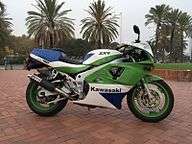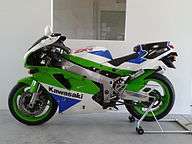Kawasaki Ninja ZX-7R
The Kawasaki Ninja ZX-7R was a motorcycle in the Ninja sport bike series from the Japanese manufacturer Kawasaki produced from 1989 until 2003. It remained largely unchanged through its production. Kawasaki used inverted forks starting in 1991, added ram air using a single tube, and in 1996, twin tube ram air and Tokico six piston brakes and fully adjustable suspension. From 1989 through 1995 in the US market, Kawasaki called the ZXR-750 and ZXR-750R the ZX-7 and ZX-7R respectively. Starting from 1996 Kawasaki dropped the ZXR name worldwide and the former ZXR-750 was now ZX-7R and the limited edition homologation special ZXR-750R/ZX-7R started in 1991 was now ZX-7RR.[6][1]
 | |
| Manufacturer | Kawasaki Motorcycle & Engine Company |
|---|---|
| Also called | 1989 to 1995 ZXR-750 - ZXR-750R 1989 to 1995 US ZX-7 - ZX-7R 1996 to 2003 ZX-7R - ZX-7RR |
| Parent company | Kawasaki Heavy Industries |
| Production | 1989-2003 |
| Predecessor | GPX750R |
| Class | Sport bike |
| Engine | 748 cc (45.6 cu in) four-stroke, liquid-cooled, 16-valve DOHC , inline-four |
| Bore / stroke | 73.0 mm × 44.7 mm (2.87 in × 1.76 in) |
| Compression ratio | 11.5:1 |
| Top speed | 241–262 km/h (150–163 mph)[1][2][3][4] |
| Power | 77.6–81.4 kW (104.0–109.2 hp) (rear wheel) @ 11,500 rpm[4] |
| Torque | 71.0–76.5 N⋅m (52.4–56.4 lb⋅ft) (rear wheel) @ 9,000 rpm[4] |
| Frame type | Aluminum twin-spar |
| Suspension | Front: adjustable 43 mm inverted cartridge fork Rear: Uni-Trak (monoshock) swingarm |
| Brakes | Front: twin 320 mm (13 in) semi-floating front discs with Tokico six-piston calipers Rear: 230 mm (9.1 in) disc with twin-piston opposed caliper. |
| Tires | 120/70ZR17, 190/50ZR17 |
| Rake, trail | 25.0°, 3.9 in (99 mm) |
| Wheelbase | 1,440 mm (56.5 in) |
| Seat height | 780 mm (30.9 in) |
| Weight | 210 kg (460 lb)[2] (dry) 235–239 kg (518–527 lb)[4][5] (wet) |
| Fuel capacity | 18 l; 4.0 imp gal (4.8 US gal) |
| Oil capacity | 3,600 ml (3.8 US qt) |
| Related | Kawasaki ZXR250 Kawasaki ZXR400 Kawasaki Ninja ZX-6R Kawasaki Ninja ZX-9R Kawasaki Ninja ZX-12R |
Overview
The ZX-7R has a 749 cc in-line four-cylinder, four-stroke engine.
The frame used on the ZX-7R is a lightweight aluminum twin-spar item, designed using computer-aided design to optimize strength. The rear subframe was constructed using steel, providing enough strength for a pillion passenger.
The swingarm used largely the same fabrication techniques to produce a hollow cast and pressed aluminum alloy hybrid swingarm, and the Uni-Trak rear suspension system features a predominantly lightweight alloy and aluminum construction. The Uni-Trak system was designed to provide a progressively stiffer damping and spring rate under compression. The rear suspension unit is fully adjustable in terms of damping, preload and compression.
The front suspension found on the ZX-7R comprises a fully adjustable 8-way compression and 12-way rebound 43 mm inverted cartridge fork.
Front brakes are 320 mm semi-floating front discs and Tokico six-piston calipers. Rear brakes feature a 230 mm disc with a twin-piston opposed caliper.
The ZX-7RR differs from the road model with an adjustable head-stock angle, swing arm pivot, additional increased adjustability 28-way compression and 13-way rebound to the front and 14-way rebound for the rear suspension, ten more than the R model, a solo cowl with a different aluminum subframe, and 41 mm flat-slide carburetors versus the 38mm on the base R model. It also has a close ratio gear-box fitted as standard and a crankshaft flywheel that is heavier and Nissin front brake calipers.[3][7][8]
Cycle World recorded a 0 to 1⁄4 mi (0.00 to 0.40 km) time of 10.82 seconds at 129.68 mph (208.70 km/h).[2]
Racing
The ZX-7RR was raced, winning 12 AMA superbike championships. Kawasaki's Road Racing team riders were Eric Bostrom, Doug Chandler and Scott Russell. Doug Toland won the 1993 Endurance FIM World Championship. Andreas Hofmann won the 1997 Macau Grand Prix.



References
- "Kawasaki ZXR750 Road Test". Classic-Motorbikes.net. March 7, 2012. Retrieved April 19, 2017.
- Ienatsch, Nick (May 27, 2013). "Superbikes With Soul: Classic vs. Modern Superbike Comparison Test". Cycle World. Retrieved October 29, 2016.
- "1996 Kawasaki ZX-7R". Cycle World. March 1996. pp. 43–48.
- "Performance Index Winter '12/'13 Edition" (PDF), Motorcycle Consumer News, Bowtie Magazines, January 2013, archived from the original (PDF) on 2016-12-29
- "Sportbike Weights and Measurements". Sport Rider. August 23, 2011. Retrieved September 18, 2016.
- Shippey, Mark (October 10, 2010). "Bike Icon: Kawasaki ZXR750". Visor Down. Retrieved April 19, 2017.
- Kunitsugu, Kent (January 4, 2017). "SR Archive: Kawasaki Zx-7RR Road Test Review". Sport Rider. Retrieved April 19, 2017.
- Owen, Paul (November 26, 2015), "Carbon Garage: A motorcycle cafe that's full of racers", Stuff.co.nz